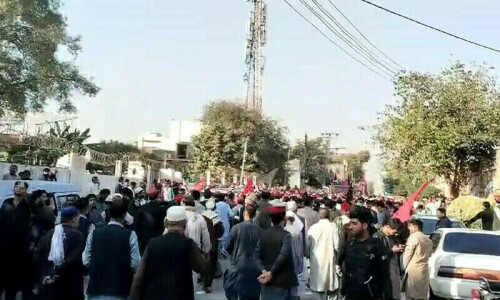JHANG, Jan 7: The proposed road bridge project over the Chenab at Chund Bharwana near Jhang is once again in the doldrums, as it has become a bone of contention between political rivals.
The river enters Jhang near Pindi Bhattian to the north and after flowing for 200 kilometres, exactly in the centre of the district, dividing it into two equal parts, leaves it downstream near Rangpur in Muzaffargarh on the western bank and Qatalpur in Khanewal on the eastern side.
The river splits all the three tehsils of the district into two parts each. Out of 18 police stations, as many as 10 lie on the eastern bank and the remaining on its western bank.
Three important national highways, one between Faisalabad and Sargodha, which goes onwards to Mianwali and Bannu, another connecting Multan with Sargodha and stretches to Islamabad and the third road linking Lahore with Layyah, Bhakkar, Dera Ismail Khan, cross the Chenab at various points in Jhang.
Along a 200-kilometre route of the river through the district, there were only three bridges built by the British government in the beginning of the 20th century. Near Chiniot is a rail-cum-road bridge, the road flying over the rail bridge.
Recently, a new two-lane road bridge had been constructed parallel to the century-old bridge. The second road bridge is situated 120 kilometres downstream on the Trimu headworks.
The third and last bridge lies between the other two bridges at Chund Bharwana. Being the shortest road route between Karachi, Rahim Yar Khan and Multan in the south and Sargodha, Islamabad and Peshawar in the north, this bridge is built on the most important highway on this route. This single-lane rail-cum-road, called the Riwaz bridge, was built in 1904, having eleven spans, each 200 feet in length.
This bridge was exclusively built to take the railway track across the river, but within few years a metalled road was built on the railway track for automobiles that started crossing this bridge. There were very few trains running on this section and so was the vehicular traffic on the Jhang, Kot Issa Shah, Sargodha Road, a major part of which remained non-non-metalled even after independence.
At that time buses and few other motorists did not face any problem in crossing the bridge and they had to wait for little while at the bridge when a train used to come from either side. Consequently, there was no hassle of waiting in long queues of vehicles for crossing the bridge.After the creation of Pakistan, however, the number of trains running on this section and volume of vehicular traffic increased manifold. The need for a separate road bridge on this busy route was felt by early 1950s.
The people of the district elected many people to plead their case in the assemblies, some of whom became ministers, but none of them made any real effort to have the new bridge approved or constructed. As the traffic problems multiplied, driving on the Riwaz bridge became an headache for the motorists. To avoid it, people coming from long distances opted for an alternative route, though comparatively lengthy, to reach their destinations earlier.
But for those travelling to the other part of the district on the western bank of the river, or to Sargodha, Shahpur and Khushab, which were at shorter distance from Jhang, no other option was available.
A project of national importance was reduced to the status of a local problem and the high-ups stopped bothering about it. In the 1985 and 1988 elections, it again surfaced as a big issue and people voted for Abida Husain and Faisal Saleh Hayat, respectively, in the two elections in the hope that they would fulfil their promises of making sincere efforts to get the bridge constructed.
Abida Husain was elected to the National Assembly in 1985 and Mr Hayat in 1988 from an area, which was in need of the bridge. The latter became an influential minister in the Benazir Bhutto's federal cabinet and made efforts to get the new bridge sanctioned in which he succeeded.
In early 1990s, funds were allocated and transferred to the account of the National Highway Board, now the NHA, the bridge's design approved and contract was awarded to a firm to construct the bridge at a cost of Rs220 million.
The NHB had established its office in Jhang and the date of laying foundation stone was fixed when all of a sudden the Benazir's government was dismissed by the president and the caretaker government ignored the project.
In the 1993-1996 tenure of Benazir Bhutto's regime, efforts were made to revive the project, but scarce funds prevented it from being materialized. Again when Mr Hayat became the federal interior minister in the Jamali cabinet, he resumed his efforts to get the bridge built.
His efforts bore fruit and the project was reportedly approved by the federal government to be built at a cost of Rs620 million, a price thrice the one approved in 1990. A date was fixed for the laying of the foundation stone by Prime Minister Mir Zafarullah Khan Jamali and Faisal Saleh Hayat. But this time, Mr Hayat's stated strained relations with Punjab Chief Minister Chaudhry Pervaiz Elahi threw a spanner on the project.
However, realizing the importance of the project, several MPAs of the district, all belonging to the PML-Q, demanded the government that the project be continued and ceremony performed jointly by the prime minister and the chief minister in the presence of all the MPs.
On the other hand, Mr Hayat feels that since the bridge is to be built in his constituency through his personal efforts and the funds allocated by the federal government, the Punjab government, chief minister and MPAs should have nothing to do with the stone-laying ceremony and it shall be performed by any representative of the federal government.













































Dear visitor, the comments section is undergoing an overhaul and will return soon.